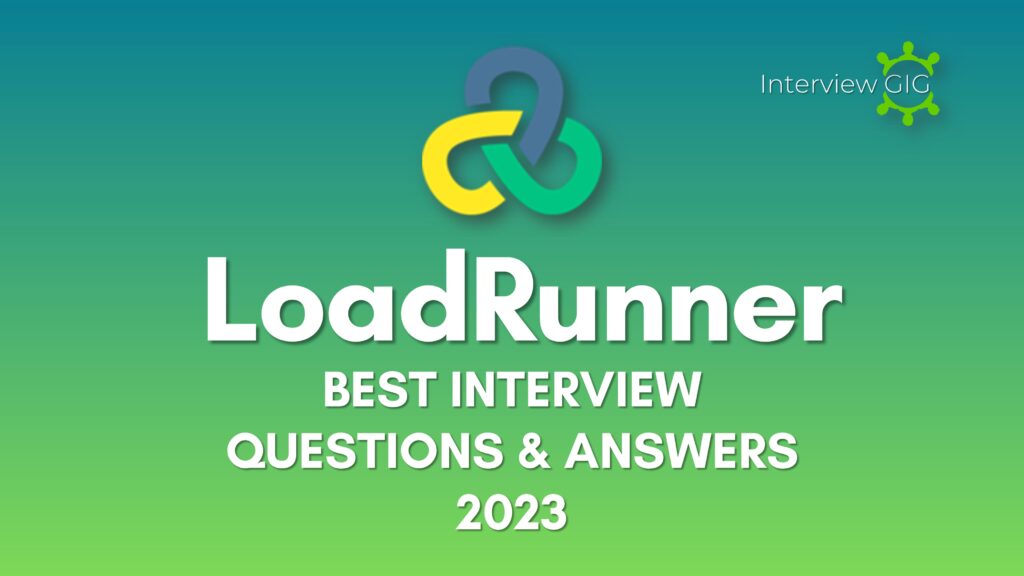What is load testing?
Load testing is to test that if the application works well with the loads from large number of simultaneous users and transactions. It also used to determine whether it can handle peak usage periods.
What is loadrunner?
LoadRunner is a performance testing tool from HP. This tool supports all aspects such as Load, Stress, Endurance, data volume and spike Testing.
What are all the components of Loadrunner?
Following are the components of Load Runner
- The Virtual User Generator
- Controller, and the Agent process
- LoadRunner Analysis and Monitoring
- LoadRunner Books Online
What Component of LoadRunner is used to record a script?
The Virtual User Generator (VuGen) component is used to record a script and it enables you to develop V user scripts for a variety of application types and communication protocols.
What is a rendezvous point?
Rendezvous points are introduced into V user scripts to simulate more users on the server. Rendezvous points instruct V users to wait during test execution in order to perform the tasks simultaneously.
For example, in a banking application, Rendezvous points are inserted for 100+ multiple users to deposit money simultaneously.
What is a scenario?
A scenario is nothing but an event that occurs for each testing session.
For example, a scenario defines
- Number of users
- Action to be performed
- Virtual machines system
How can we debug a LoadRunner script?
VuGen contains two options to debug V user scripts
We can also manually set the message class within your script using the lr_set_debug_message function.
How can we perform functional testing under load?
Functionality under load can be tested by running several V users concurrently. By increasing the V users, it is necessary to determine how much load the server can sustain.
What is the relationship between Response Time and Throughput?
The Throughput shows the amount of data in bytes that the V users received from the server in a second. When It is compared with transaction response time, throughput and response time get decreased.
The peak throughput and highest response time would occur approximately at the same time.
What does vuser_init and vuser_end action contain?
Vuser_init action contains procedures to login to a server and Vuser_end section contains log off procedures.
What is the difference between standard log and extended log?
The standard log sends a subset of functions and messages to the output log and subset of functions depends on the V user type.
Extended log sends a detailed script execution messages to the output log. It is mainly used during debugging when user needs information about Parameter substitution.
What are all the types of Goals in Goal-Oriented Scenario of LoadRunner?
LoadRunner provides you with five different types of goals:
- Number of concurrent V users
- no of hits per second
- transactions per second
- no of pages per minute
- Transaction response time
What is a function to capture dynamic values in the web vuser script?
Web_reg_save_param is the function that saves dynamic data information to a parameter.
What are the LoadRunner testing process?
Following are the testing process in LoadRunner:
- Plan load test
- Create Vuser Scripts
- Define Scenario
- Run Scenario
- Analyze results
What is remote command launcher?
The remote command launcher enables the controller to start applications in the host machine.
How can we develop the database v user script?
V user scripts can be developed either by recording with the load v user script generator or by using Loadrunner v user script template.
How do you load a loadrunner Agent?
While running the scenario, load runner controller instructs the remote agent dispatcher to launch loadrunner agent. The controller instructs the load runner agent to initialize, run, pause and stop the v users.
What is the difference between hits/second and requests/second?
Hits per second means the number of hits the server receives in one second from the vuser.
Request per second is the number of request the vuser will request from the server.
What are the advantages of loadrunner?
Following are the advantages of LoadRunner:
- Reduces human intervention
- Reduces the requirement of the systems
- Helps in the better usage of time and money
- Effective utilization of automation
- Single point execution
What is the v user in the scenario?
The v user is the virtual users who can simulate the real users. The virtual users who take the place of real users’ operating client software, such as IE sending requests using the HTTP protocol to IIS or Apache web servers.
How do we write a user defined function in LoadRunner?
Use should create the external library that contains the function. This library must then be added to the bin directory of VuGen. And then, the user-defined function can be assigned as a parameter.
What are the changes that can be made to run-time settings?
There are four run-time settings that can be made:
- Pacing: This contains iteration count.
- Log: Logging can be set to standard or disabled.
- Think Time: Capable of setting think time to be ignored or replayed.
- General: Allows the setting of V users for processes or multithreading.
How can we find database related issues?
Monitors and the Data Resource Graph can be used to find database related issues. Load Runner allow the tester to specify the resource that needs to be measured before the controller is run.
How many types of graphs are available in LoadRunner?
There are 4 types of graphs:
- Network delay time graph – displays the time that elapses between request and response
- Two transaction response time graphs – one transaction response time graph for load and another one for percentile
- Hits/second graph – Shows application traffic volume
- Pages download/second graph – shows the rate at which pages are downloaded per second
How can performance bottlenecks can be identified?
Monitors can be used to detect performance bottlenecks. These include network, web server, application server, and database server monitors.
These monitors can be used to locate trouble spots in scenarios that cause increase in response time and throughput, network delays, performance response time, hits/second, etc.
What is ramp up and how it can be set?
Ramp up is gradually increasing the load on a server and can be simulated by gradually increasing the number of V users. This feature can be found in the Scenario Scheduling Options.
How correlation can be performed?
Correlation can be performed in two ways:
- Use the scan function to search for correlations and select a value from the result.
- Record a pair of scripts and then compare them to each other.
Where are automatic correlation options set?
The automatic correlation is set in recording options area on the correlation tab. Correlation can be enabled for the full script and rules for correlation can be defined.
Automatic correlation can be performed on a database by viewing the output window, scanning for correlation, and selecting the value that will be used.
What is the benefit of running a V user script as a thread?
The advantage of running a V user script as a thread which allows more Vusers to be used for one load generator. Running V user scripts as processes utilizes a lot of memory because all of the loaded scripts use the same driver.
This limits the number of V user scripts that can be run on one generator.
What is the difference between Overlay graph and Correlate graph?
Overlay Graph:
Overlay graph has one X axis and 2 Y-axis. Left Y-axis on the merged graph shows the current graph’s value & Right Y-axis show the value of Y-axis of the graph that was merged.
Correlate Graph:
There are two graphs and the active graph’s Y-axis becomes X-axis of merged graph. Y-axis of the graph that was merged becomes merged graph’s Y-axis.
What are the three sections of a V user script and what is the purpose of each one?
Following are the three sections of V user script and they are as follows:
- Vuser_init – Used for recording the logon.
- Actions – Used for recording the business process.
- Vuser_end – Used for recording the logoff.
What are the four selection methods when choosing data from a data file?
Following are the four selection methods:
- Sequential
- Random
- Unique
- Parameter name
What should be done to view parameter substitution in the Execution Log?
Parameter substitution can be viewed in the extended log in the Run time settings.
What tools are required to analyze V user run results?
Following tools are required to analyze V user run results:
- Execution Log
- Run-Time Viewer and
- Mercury Test Results window
What is difference between Manual scenario and Goal oriented scenario?
Following are the differences between Manual and Goal Oriented scenario:
| Manual Scenario |
Goal Scenario |
| Main purpose is to learn how many V users can run concurrently |
Goal may be throughput, response time, or number of concurrent V users |
| Gives you manual control over how many V users run and at what time |
Load Runner manages V users automatically |
What are all the reasons to use the Server Resources Monitor?
Server resources monitor is used to find how much data is coming from Cache and helps to find out what are all the parts of the system have bottlenecks.
What is the purpose of selecting ‘Show browser’ during replay in the General Options settings?
‘Show Browser’ setting is used to see the pages that appear during playback. This is useful for debugging V user during the initial stages of Web V user creation.
For what purpose, User will be using ‘continue on’ error?
Continue on should be set only when making Execution Logs more descriptive or adding logic to the V user.
What is the purpose of a Load Runner transaction?
The purpose of a Load Runner transaction is to measure one or more steps/user actions of a business process.
Why do you create parameters?
Parameters are like script variables and they are used to vary input to the server to emulate real users.
- Different sets of data are sent to the server whenever the script is run.
- Better simulate the usage model for more accurate testing from the Controller and one script can emulate many different users on the system.
What is lr_output_message?
The lr_output_message is a function that sends notifications to the Controller Output window and to the V user log file.





